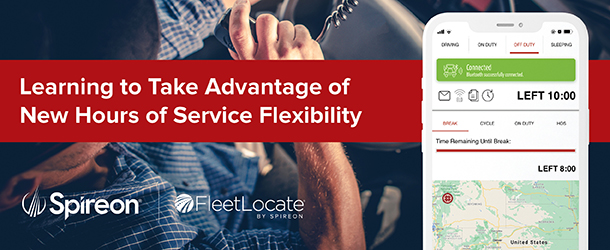By P. Sean Garney, Scopelitis Transportation Consulting LLC and Safety/Regulatory Consultant to Spireon, Inc.
As we approach the one-year anniversary of the publication of the latest changes to the Hours of Service rules, now might be a good time to reflect on the 8 months the rules have been effective and how fleets are using them to gain efficiency. It’s too early to measure the safety impacts but we can use anecdotal evidence from carriers and drivers to understand their impact on fatigue.
CMV Short-haul Exemption (49 CFR §395.1(e)(1)) – FMCSA lengthened the maximum on-duty period and air-mile radius for the CDL driver short-haul exemption to 14 consecutive hours and 150 air-miles, respectively. For drivers who operated near the 100-air mile mark or who’s routes kept them on the road longer during the day, this change has been a big relief.
Carriers are finding more of their routes are eligible for the recordkeeping exception, meaning they don’t need to adopt ELDs and can keep simplified timecard like records. Some drivers are reporting less stress because they have two more hours to complete their run, though others are adding stops, forgoing any stress reduction benefits. Because drivers are still required to take 10 hours off-duty between shifts and are not allowed to operate passed the 14-hour window, most are not predicting any increase in fatigue related crashes in this segment.
Adverse Driving Conditions (49 CFR §395.1(b)(1)) — FMCSA’s rule change allows drivers who encounter unexpected adverse driving conditions to extend their 14-hour driving window by an additional two hours to complete their run for the day. Because encountering adverse driving conditions is, by definition, a rare and unexpected circumstance, minimal safety impact is expected. That said, its use is increasing.
The previous rules created an unworkable and unlikely scenario where a driver needs extra driving time to navigate the difficult conditions but still has time left in the 14-hour window to complete the run. Ultimately, this meant the driver drove for all but one hour of a 14-hour shift, a practical impossibility. By allowing drivers to also extend their 14-hour driving window by two hours, more drivers can safety navigate unexpected conditions without stressing over their 14-hour clock.
30 Minute Rest Break (49 CFR §395.3(a)(3)) — FMCSA modified the existing 30-minute rest break requirement such that a break is only required after a driver accumulates eight hours of driving time (as opposed to on-duty time). This break can be satisfied using “on-duty, not driving” time and/or “off-duty” time. This is the probably the change with the biggest impact on drivers.
Very few drivers drive more than eight hours in an average shift and those that do most likely had a qualifying on-duty not driving period already logged, meaning there’s no need to stop. In fact, according to FMCSA data, before the change 73.4% of drivers were required to take a 30-minute off-duty rest break in the average shift compared to only 17.3% after the change. The impact of this change on safety is still unclear, but some in law enforcement are reporting that many drivers are still taking breaks in the same way they did before the change, suggesting the negative impact may not be substantial.
Split Sleeper Berth Rule (49 C.F.R. §395.1(g)) – FMCSA’s rule change allows drivers using the split-sleeper-berth exception to split their off-duty periods into two off-duty periods, provided one is at least two hours and the other involves at least seven consecutive hours spent in the sleeper berth, and when added together they equal at least 10 hours (e.g. 7/3, 7.5/2.5, 8/2 etc). While this ranks as one of the more confusing changes to the hours-of-service rules, it can also be one of the most advantageous. That’s because the change in the rules and the way they’re enforced make it easier and advantageous to take the shorter off-duty period first. Drivers of sleeper berth equipped trucks now have the opportunity to pause their 14-hour clock to account for delays in loading or to avoid traffic, provided they can pair the break with a longer sleeper berth period later in the day. Data on its use is still limited and drivers are still getting used the new rules, so its impacts on safety are yet unknown, but there’s no doubt many will benefit from this additional flexibility.

